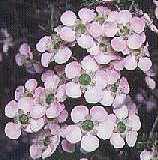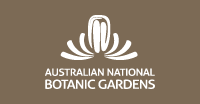Leptospermum - family Myrtaceae
Commonly known as 'teatrees'
 Commonly referred to as Teatree, Leptospermum is distributed in Australia, South East Asia (i.e. the Malay peninsula, Sumatra, Borneo, Java, Philippines, Sulawesi, Thailand, Flores, Moluccas, southern Burma and New Guinea) and New Zealand. Whilst Leptospermum occupies a variety of habitats from coastal dunes to high mountain peaks, it is most commonly found in wet or periodically wet substrates that are acidic and low in nutrient content.
Commonly referred to as Teatree, Leptospermum is distributed in Australia, South East Asia (i.e. the Malay peninsula, Sumatra, Borneo, Java, Philippines, Sulawesi, Thailand, Flores, Moluccas, southern Burma and New Guinea) and New Zealand. Whilst Leptospermum occupies a variety of habitats from coastal dunes to high mountain peaks, it is most commonly found in wet or periodically wet substrates that are acidic and low in nutrient content.
Leptospermum is in the sub-family Leptospermoideae of family Myrtaceae and currently comprises 86 recognized species. About 83 species occur in Australia, all but two endemic. The genus Leptospermum was first recognized by Johann Reinhold Forster and his son Johann Georg Adam Forster when they published the name L. scoparium Forst. & G.Forst. in 1776.
George Bentham was the first to treat the genus in his 1866 Flora Australiensis. Bentham recognized 20 species and his comments that the "... species are very difficult to distinguish" and that from "the dried specimens, whether of the species here admitted or of the varieties or races, I have been unable to discover any positive discriminating characters" are evidence of the problematic nature of the genus. Doubtless, some of these difficulties would have arisen from Bentham's broad concept of Leptospermum, which included species now assigned to Homalospermum Schauer, Neofabricia J.Thompson and Pericalymma (Endl.) Endl. In 1983 Thompson reinstated the genera Homalospermum and Pericalymma, described Neofabricia (based in part upon the genus Fabricia Gaertner) and then in 1989 published a revision of the genus Leptospermum. Thompson recognized 79 species with 27 of these being described as new. In 1992 Bean described another two species and clarified taxonomic problems associated with two northern Australian and Malesian taxa. In 1993 Lyne and in 1996 Lyne and Crisp published descriptions of another two new species.
The common name tea-tree derives from the practice of early settlers of soaking the leaves of several species in boiling water to make a tea substitute. Most Leptospermum species make desirable garden plants. Flowers are mostly large, up to 3 cm in diameter, and they are hardy in most soils and aspects.
They are easy to propagate from seed or cuttings. Several cultivars have been established in the trade for many years. These have originated mainly from L. scoparium, a species that Australia shares with New Zealand. Most of the cultivars have developed from New Zealand stock and have occurred as chance seedlings in nurseries of other countries; that is, the United States, Ireland and the United Kingdom. With concentrated breeding effort, Australian species will produce hybrids far superior to these in terms of vigour and disease resistance. As is well known, most of the L. scoparium cultivars are prone to scale and the associated black smut. Many Leptospermum species make useful screen plants as most have a tight, compact growth. Species that flower on the new wood may be used as cut flowers.
Text used below in this web-site is by John Wrigley from the the book Australian Native Plants, 4th edition, by John Wrigley and Murray Fagg, published by Reed Books, November 1996. |
Commonly grown Leptospermum species
Leptospermum madidum subsp. sativum
Leptospermum polygalifolium 'Pacific Beauty'
![An Australian Government Initiative [logo]](/images/austgovt_brown_90px.gif)







